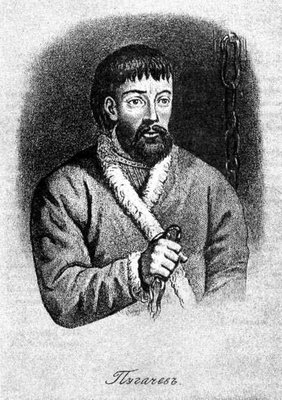"The Captain's Daughter" (1836) by Alexander Pushkin

Source: Russian Pushkin site
Yemelyan Ivanovich Pugachev (shown in this picture) was was a pretender to the Russian throne during the reign of Catherine II. Claiming to be Czar Peter III, Pugachev led a Cossack rebellion in the lower Volga region from 1773-1774. The pretender was executed in 1775.
According to Wikipedia, Pugachev "recruited priests and mullahs to disseminate his decrees and read them to the masses as a way of lending them credence.
Priests in particular were instrumental figures in carrying out Pugachev’s propaganda campaigns. Pugachev was known to stage “heroic welcomes” whenever he entered a Russian village, in which he would be greeted by the masses as their sovereign. A few days before his arrival to a given city or village, messengers would be sent out to inform the priests and deacons in that town of his impending arrival. These messengers would request that the priests bring out salt and water and ring the church bells to signify his coming. The priests would also be instructed to read Pugachev’s manifestos during mass and sing prayers to the health of the Great Emperor Peter III. Most priests, although not all, complied with Pugachev’s requests." [Wikipedia]
The Russian writer Alexander Pushkin wrote a history of the rebellion and penned a romanticized account of Pugachev's Rebellion in his 1836 novel The Captain's Daughter.
MY father, Andrey Petrovitch Grinyov, had in his youth served under Count Miinnich and retired with the rank of first Major in 17—. From that time onwards he lived on his estate in the province of Simbirsk, where he married Avdotya Vassilyevna U., daughter of a poor landowner of the district. There had been nine of us. All my brothers and sisters died in infancy. Through the kindness of Prince B., our near relative, who was a major of the Guards, I was registered as sergeant in the Semyonovsky regiment. [Full text]

0 Comments:
Post a Comment
<< Home